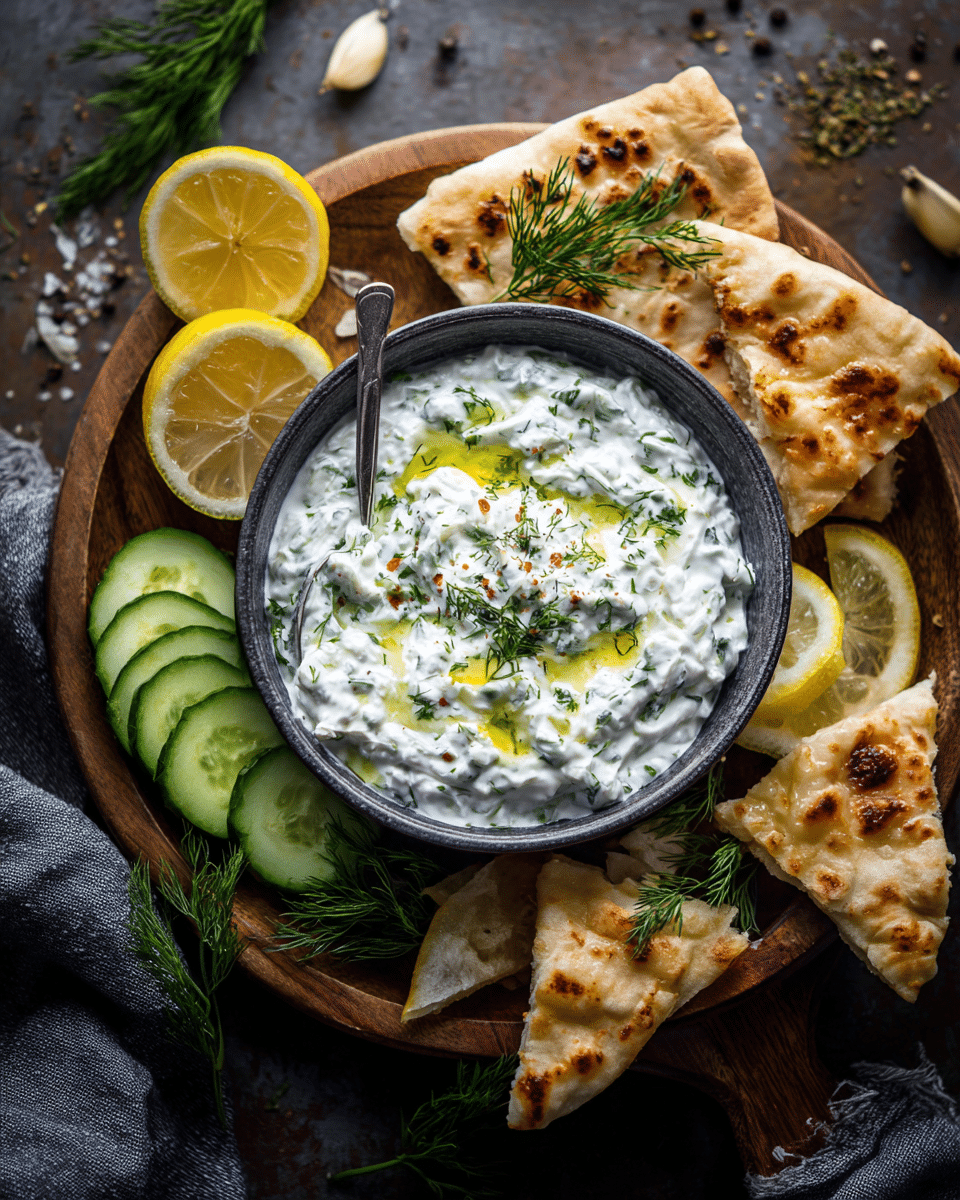Greek Tzatziki Dip is a cool, creamy condiment that combines tangy yogurt, fresh cucumber, zesty garlic, and aromatic herbs. Originating from Greece, this versatile dip pairs beautifully with pita bread, grilled meats, or fresh vegetables.
FULL RECIPE
Ingredients
- 2 cups plain Greek yogurt (full-fat or low-fat)
- 1 medium cucumber, peeled, seeded, and finely grated
- 2–3 garlic cloves, minced
- 2 tablespoons extra-virgin olive oil
- 1 tablespoon fresh lemon juice
- 2 tablespoons fresh dill, finely chopped (or mint for variation)
- ½ teaspoon salt (or to taste)
- ¼ teaspoon freshly ground black pepper
Directions
- Place the grated cucumber in a fine-mesh strainer or cheesecloth, sprinkle lightly with salt, and let sit for 10–15 minutes to draw out excess moisture.
- Squeeze the cucumber firmly to remove as much liquid as possible.
- In a medium mixing bowl, combine Greek yogurt, cucumber, minced garlic, olive oil, lemon juice, and dill.
- Stir until all ingredients are well incorporated and the dip has a smooth texture.
- Season with salt and pepper, adjusting to taste.
- Cover and refrigerate for at least 1 hour to allow flavors to blend.
- Serve chilled with pita bread, crackers, or fresh vegetables.
Nutrition Facts
- Calories: 70
- Protein: 4g
- Fat: 4g
- Saturated Fat: 1g
- Carbohydrates: 3g
- Fiber: 0g
- Sugars: 2g
- Sodium: 150mg
- Cholesterol: 3mg
Origins of Greek Tzatziki
Greek Tzatziki has deep roots in Mediterranean culinary traditions, particularly within Greek and Middle Eastern cuisine. It is believed to have evolved from ancient yogurt-based dishes that were flavored with herbs and vegetables for both taste and preservation. In Greece, tzatziki is commonly served alongside grilled meats like souvlaki and gyros, as well as with warm pita bread. Its popularity spread across the region due to its refreshing flavor and its ability to balance heavier, spiced foods. Over time, each culture has adapted the dip slightly, incorporating regional herbs and techniques, but the essence of tzatziki remains unchanged: a cool, creamy blend of yogurt, cucumber, garlic, and herbs.
Nutritional Benefits of Tzatziki
Tzatziki is not just delicious but also a healthy addition to your diet. Greek yogurt is a rich source of protein, probiotics, and calcium, supporting muscle health, digestion, and bone strength. Cucumbers provide hydration due to their high water content and offer vitamins like vitamin K for bone health and antioxidants for cellular protection. Olive oil in tzatziki delivers heart-healthy monounsaturated fats, while garlic adds antibacterial and anti-inflammatory benefits. Dill or mint, commonly used in the recipe, provides additional antioxidants and micronutrients. Overall, tzatziki is a nutrient-dense, low-calorie dip that can fit into many healthy eating plans.
Traditional Serving Methods
In Greece, tzatziki is often served as a meze, a small plate meant for sharing, alongside other dishes such as hummus, baba ganoush, and dolmades. It frequently accompanies grilled meats, seafood, and roasted vegetables, providing a cooling counterpoint to savory and spiced flavors. Tzatziki is also a standard condiment in pita wraps, where it adds creaminess and a fresh burst of flavor to fillings like lamb, chicken, or falafel. At traditional Greek tavernas, you may even find tzatziki served as a side dish to freshly baked bread, making it a simple yet satisfying start to a meal.
Variations Across Regions
While the classic Greek version of tzatziki uses dill, cucumber, and garlic, variations can be found across the Mediterranean and Middle East. In Turkey, a similar dish called cacık is thinner in consistency and often served as a chilled soup with additional herbs. In Bulgaria, tarator combines yogurt, cucumber, and dill with walnuts for added texture. Some modern Greek recipes substitute mint for dill, while others incorporate parsley or chives. There are even vegan adaptations that replace Greek yogurt with plant-based yogurt made from coconut, almond, or soy milk, making tzatziki accessible to a wider range of dietary preferences.
Pairing Tzatziki with Foods
The creamy tang of tzatziki pairs exceptionally well with both grilled and roasted meats, including lamb chops, chicken skewers, and beef kebabs. Its refreshing taste also complements seafood, such as grilled shrimp or baked salmon. For vegetarian pairings, roasted eggplant, grilled zucchini, and falafel are ideal companions. Tzatziki also works as a dipping sauce for warm pita bread, pita chips, or fresh vegetable crudités. For a more unconventional pairing, try serving it alongside baked potatoes or as a creamy topping for veggie burgers—it adds both moisture and flavor without overpowering the dish.
Texture and Flavor Profile
Tzatziki’s appeal lies in its balance of creamy, tangy, and refreshing elements. The Greek yogurt base provides a thick, rich texture with a pleasantly tangy taste, while grated cucumber adds a light crunch and freshness. Garlic infuses the dip with a sharp, aromatic bite, which is softened by the yogurt. The olive oil contributes a subtle smoothness, and the dill or mint adds a fragrant herbal note. When chilled, tzatziki has a cooling effect, making it especially popular during warmer months or as an accompaniment to spicy and grilled foods.
Storage and Shelf Life
Homemade tzatziki is best stored in an airtight container in the refrigerator and consumed within 3–4 days for maximum freshness. Because it contains fresh cucumber and herbs, its water content can cause the dip to become slightly watery over time; this can be fixed by stirring before serving. For longer storage, keep the cucumber separate and mix it into the yogurt base just before serving. Freezing tzatziki is not recommended, as the yogurt’s texture can separate and become grainy once thawed, diminishing the creamy consistency that makes it so appealing.
Tips for Perfect Tzatziki
Achieving the perfect tzatziki requires attention to detail, particularly with cucumber preparation. Squeezing out excess moisture from the grated cucumber is crucial to preventing a watery dip. Using high-quality Greek yogurt ensures a thick and creamy texture, while fresh herbs make a noticeable difference in flavor. Adjusting garlic levels to suit personal preference can also improve the balance of the dip—some prefer a milder taste, while others enjoy a strong garlicky punch. For an extra burst of flavor, a pinch of lemon zest or a drizzle of extra-virgin olive oil on top before serving can elevate the presentation and taste.
Health-Conscious Adaptations
For those watching their calorie or fat intake, low-fat Greek yogurt can be used without sacrificing too much creaminess. To reduce sodium, limit the added salt or use a small amount of sea salt for a milder flavor. A dairy-free version can be made by substituting coconut or almond yogurt, although these will slightly alter the taste. Adding finely chopped spinach or kale can increase the nutrient profile, while omitting or reducing the olive oil will further lower the fat content. These adaptations make tzatziki an inclusive dish that fits into a variety of dietary needs.
Creative Uses Beyond Dipping
While tzatziki is best known as a dip, it can also serve as a flavorful sauce, dressing, or spread. It works wonderfully as a topping for baked fish, a creamy layer in sandwiches or wraps, and even as a salad dressing when thinned with a little water or lemon juice. It can replace mayonnaise in potato salad or coleslaw for a lighter, tangier version. Some creative home cooks even use tzatziki as a base for cold pasta salads, combining it with cherry tomatoes, olives, and feta cheese for a Mediterranean twist.
Conclusion
Greek Tzatziki is far more than a simple dip it’s a versatile, flavorful, and nutrient-rich addition to countless meals. Its cooling, tangy profile makes it the perfect balance to bold and spicy dishes, while its wholesome ingredients offer both taste and health benefits. Whether enjoyed in its traditional form with grilled meats and pita bread, adapted for dietary needs, or reinvented in creative recipes, tzatziki remains a timeless staple of Mediterranean cuisine.






